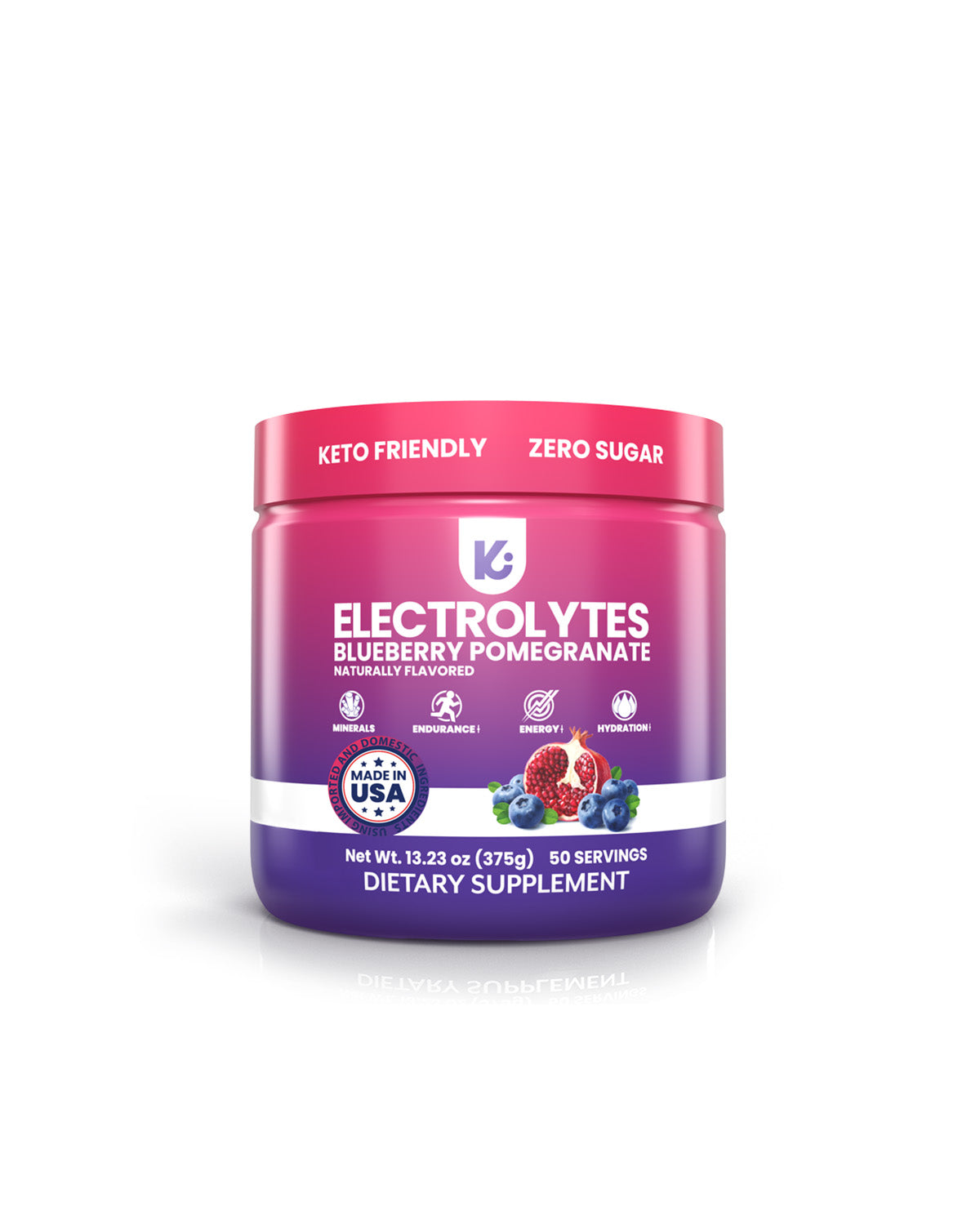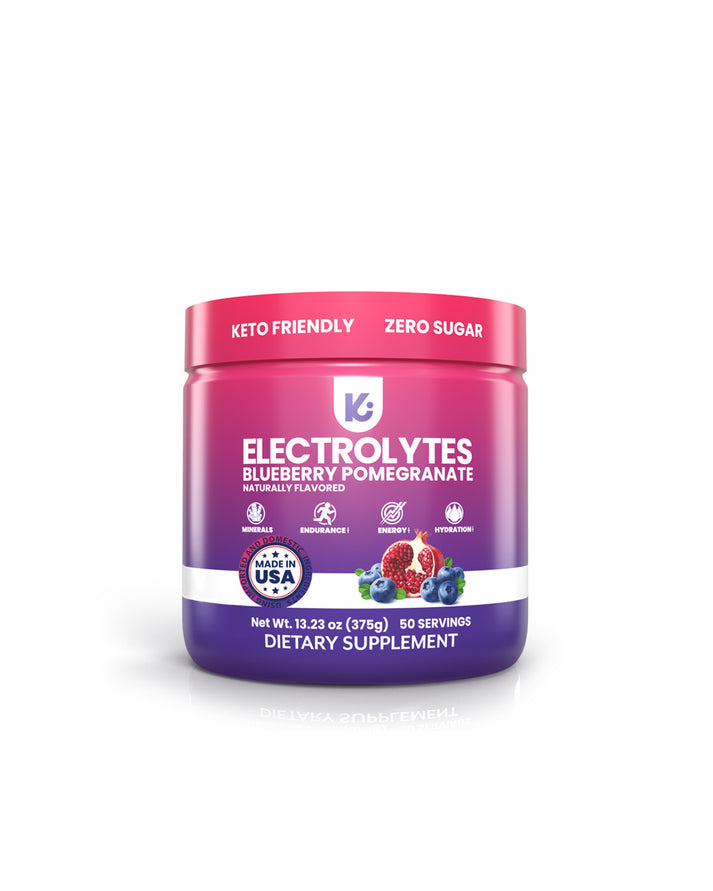Keto Electrolytes, Everyday Energy: Build a Better Hydration Stack with Key Minerals
Share
Why Key Minerals Matter in Electrolyte Powders
Primary keywords used: electrolyte powder, electrolytes for hydration, sodium potassium magnesium calcium, sugar-free electrolyte powder, best electrolyte powder, electrolyte drink mix, clean hydration, workout recovery, keto electrolytes.
Ever notice how plain water sometimes feels flat after a sweaty workout, flight, or long shift? That sluggish feeling marks the beginning of an electrolyte gap, a pain point rooted in tiny charged minerals your body loses through sweat (Shrimanker & Bhattarai, 2023). Sodium, potassium, magnesium and calcium steer nerve signals, muscle twitches and fluid flow (MedlinePlus, 2024). When they dip, the problem spreads into cramps, fog and fatigue, turning a simple hydration issue into a full-body challenge (Jung et al., 2005; Shrimanker & Bhattarai, 2023).
Here’s the overview: this introduction gives you practical context and shows why the right mix of minerals builds the foundation for steady energy. You’ll get a clear roadmap of each key element and how a clean, sugar-free electrolyte powder like Keppi’s blend tackles the issue (Verywell Health, 2025).
What You'll Learn about “Which minerals are commonly found in electrolyte powders?”
- Sodium & chloride team up for rapid fluid balance.
- Potassium steadies heartbeat and keeps muscles firing smoothly.
- Magnesium fuels energy steps and calms post-workout cramps.
- Calcium supports contractions while reinforcing bone structure.
- Trace extras like phosphorus fine-tune hydration.
Quick Summary
Electrolyte powders restore hydration by replenishing essential minerals lost through sweat—sodium, chloride, potassium, magnesium, calcium and phosphorus (Shrimanker & Bhattarai, 2023; Medical News Today, 2017). These minerals support nerve function, muscle contraction and fluid balance (MedlinePlus, 2024; Medical News Today, 2017). Choosing a clean, sugar-free electrolyte powder with balanced minerals, like Keppi Electrolyte Powder, offers fast absorption for performance, workout recovery and everyday well-being—without added sugars or artificial dyes.
Learn more about the productBest Education Topics Related to “Which minerals are commonly found in electrolyte powders?”
- Sodium & Chloride – quick-acting partners for fluid balance
- Potassium – heartbeat steadier and cellular equalizer
- Magnesium – energy pathway supporter and muscle calmer
- Calcium – contraction cue and skeletal guard
- Phosphorus – behind-the-scenes energy carrier
Sodium & Chloride + How it Relates to Electrolyte Powders
Your sweat carries sodium and chloride out first, so the root cause of early cramping often traces back to this duo (Jung et al., 2005; Shrimanker & Bhattarai, 2023). A balanced electrolyte powder keeps osmotic pressure steady, helping water move into cells rather than sloshing in your stomach (MedlinePlus, 2024; Wikipedia, 2025a). That simple explanation highlights why water alone sometimes falls short during long sessions (Wikipedia, 2025a). In our Keppi blend, sodium citrate and sea-salt forms feel smoother on your palate and support quick absorption.
- Maintains nerve signaling and muscle responsiveness
- Drives rapid hydration through controlled osmotic flow
- Provides a clean taste without heavy added sugars

Potassium + How it Relates to Electrolyte Powders
Potassium balances the electrical gradient that sodium creates (MedlinePlus, 2024; Wikipedia, 2025b). That balance keeps your heartbeat regular while easing post-workout twitching. Endurance training, heat or low-carb eating are factors that can drain potassium faster than daily meals replace it (Verywell Health, 2025; EatingWell, 2025).
Using potassium citrate lowers stomach upset risk and pairs well with magnesium for smoother recovery—clearing up the misconception that only sodium matters when you sweat.
- Aids cellular fluid regulation without bloat
- Offsets high-sodium intake to support healthy blood pressure
- Works synergistically with magnesium for muscle relaxation
“Electrolytes are essential minerals that keep the body functioning smoothly… you lose these minerals through sweat, mostly salt. Water alone will not replenish the salt lost, and this is where powders and tablets can be helpful.” (MedlinePlus, 2024)
Magnesium + How it Relates to Electrolyte Powders
Magnesium activates 300+ enzymes tied to ATP production, so even a small shortfall can slow energy output (de Baaij, Hoenderop & Bindels, 2015; MedlinePlus, 2024). During prolonged sessions, topping up magnesium supports smoother contractions and calmer nerves, improving sleep quality later that night (Wikipedia, 2025c). Magnesium malate and citrate are common forms with good tolerability.
- Supports sustained energy metabolism
- Helps regulate sleep via nervous-system calming
- Contributes to protein synthesis for muscle repair
Calcium + How it Relates to Electrolyte Powders
Every muscle contraction starts with a calcium spark (MedlinePlus, 2024; Wikipedia, 2025b). While most diets supply baseline amounts, heavy sweat loss or dairy avoidance can leave a gap. A modest dose in your powder helps performance now and supports bone integrity over time (Medical News Today, 2017; Wikipedia, 2025a).
- Assists nerve signaling alongside sodium
- Bolsters skeletal integrity with consistent intake
- Lower levels may heighten late-session cramping
Phosphorus + How it Relates to Electrolyte Powders
Phosphorus forms the backbone of ATP—your cellular energy currency (Wikipedia, 2025a). Even trace additions may help maintain endurance as glycogen fades (Wikipedia, 2025a). Dipotassium phosphate supplies both phosphorus and extra potassium for dual support.
- Buffers blood pH during high exertion
- Teams with calcium to support strong teeth and bones
- Supports sustained power output in multi-hour events
Viewed together, these five minerals create a tightly linked network. Recognizing their individual roles—and the context behind dosage decisions—equips you with practical insights for choosing the best electrolyte powder that aligns with your clean hydration goals.
Mineral-Powered Hydration Solutions
Mid-session fatigue often traces straight to fluid and mineral loss (Jung et al., 2005; Shrimanker & Bhattarai, 2023). When you feel that first hint of sluggish legs, Keppi’s Blueberry Pomegranate electrolyte drink mix steps in as a direct solution. We keep it sugar-free and dye-free, so you replace only what sweat removes. Each serving restores sodium, potassium, magnesium and calcium in thoughtful ratios that keep nerve impulses firing and muscles contracting smoothly—ideal for athletes, travelers and keto electrolytes needs.
The methodology behind the blend centers on fast absorption: sodium citrate opens the door for water; potassium steadies your heartbeat; magnesium calms cramping; calcium cues muscle power—supporting workout recovery and daily hydration.
Simple Implementation Plan
- Pour one scoop (or single stick) into 16–20 oz cold water as your baseline electrolytes for hydration strategy.
- Shake or stir for ten seconds for even mineral distribution and smooth texture.
- Sip through your workout; top up every 30 minutes in heat to match sweat rate.
- Mix a second bottle post-session to speed recovery and reduce next-day fatigue.
Blueberry Pomegranate Electrolyte Drink Mix – Keppi

Enjoy refreshing, sugar-free hydration with Keppi’s rapid-dissolving Blueberry Pomegranate blend. Formulated with sodium, potassium, magnesium, calcium and trace minerals for optimal hydration, energy and muscle support—without artificial colors, fillers or dyes.
Key Benefits at a Glance
- Zero sugar keeps blood glucose stable while delivering flavor.
- Balanced sodium:potassium support helps prevent cramps (Jung et al., 2005; Shrimanker & Bhattarai, 2023).
- Fine powder dissolves fast—focus on performance, not mixing.
This strategy offers a dependable resolution for travel, training or daily hydration. With premium minerals, a clean flavor profile and an easy implementation process, you get a straightforward remedy that keeps you performing at your best.
Closing Insights & Next Steps
Remember: sodium, potassium, magnesium, calcium, chloride and phosphorus keep nerves firing, muscles contracting and fluids balanced (MedlinePlus, 2024; Medical News Today, 2017). Choosing a balanced electrolyte powder, mixing with water and sipping at steady intervals turns basic hydration into a reliable performance strategy.
At Keppi, we’ve packed those minerals into a clean, sugar-free electrolyte powder that dissolves fast, so you refuel without extra calories. Explore Keppi Electrolyte Powder for training, travel and everyday wellness.
Level Up Your Hydration
Experience clean hydration and science-backed minerals. Try Keppi Electrolyte Powder to fuel performance and well-being—zero sugar, zero artificial additives. Learn more about how it works and join thousands of satisfied customers.
Learn MoreReferences
- de Baaij, J. H. F., Hoenderop, J. G. & Bindels, R. J. (2015) Magnesium in man: implications for health and disease. Physiological Reviews, 95(1), 1–46.
- EatingWell (2025) 6 Sneaky Signs You Might Need to Take Electrolytes. EatingWell.
- Jung, A. P. et al. (2005) Influence of hydration and electrolyte supplementation on exercise-associated muscle cramps. PMC, NIH.
- Medical News Today (2017) Electrolytes: Types, purpose & normal levels.
- MedlinePlus (2024) Fluid and Electrolyte Balance. U.S. National Library of Medicine.
- Shrimanker, I. & Bhattarai, S. (2023) Electrolytes. In StatPearls. StatPearls Publishing.
- Verywell Health (2025) What Happens to Your Body When You Drink Electrolytes. Verywell Health.
- Wikipedia (2025a) Dehydration. In Wikipedia, The Free Encyclopedia.
- Wikipedia (2025b) Calcium. In Wikipedia, The Free Encyclopedia.
- Wikipedia (2025c) Magnesium deficiency. In Wikipedia, The Free Encyclopedia.
